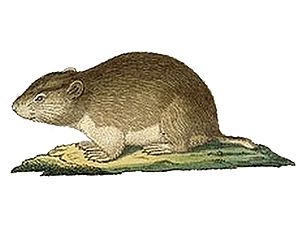Levant vole
| Levant vole | ||||||||||||
|---|---|---|---|---|---|---|---|---|---|---|---|---|

Levant vole ( Microtus socialis ) |
||||||||||||
| Systematics | ||||||||||||
|
||||||||||||
| Scientific name | ||||||||||||
| Microtus socialis | ||||||||||||
| ( Pallas , 1773) |
The Levant vole ( Microtus socialis ) is a rodent species from the genus of field mice ( Microtus ) within the voles (Arvicolinae). It occurs in Eastern Europe from the Crimea and the Dnepr as well as Eastern Turkey over large parts of Asia to the north of the People's Republic of China .
features
The Levant vole is a small vole with light fur and a short tail. It reaches a head-trunk length of 9.2 to 10.0 centimeters with a tail of 2.0 to 2.5 centimeters in length . The rear foot length is 17 to 18 millimeters. The back fur is pale sand-brown, the sides of the body are lighter and more yellowish. The peritoneum is gray, the hair has sand-colored tips. The tail is two-colored with a sand-colored brown top and a light sand-colored underside. The tops of the hands and feet are light sand to white in color and the feet have five pads on the underside.
distribution
The Levant vole occurs in eastern Europe from the Crimea and the Dnepr as well as eastern Turkey across large parts of Asia to the north of the People's Republic of China . The distribution area extends from eastern Ukraine across large parts of Russia , Armenia , Kyrgyzstan , Georgia , Azerbaijan , Tajikistan and Uzbekistan to Lake Balkhash in Kazakhstan and the northwest of Xinjiang in China. To the south it extends through the Caucasus and eastern Turkey to the southwest of Syria , Lebanon in the area of the Lebanon Mountains , northern Iraq and northwestern Iran .
Way of life
The Levant Vole lives primarily in steppe regions and how other field mice they feed on herbivores from plants, especially grasses and other herbaceous plants. In the fall, seeds dominate her diet, and she is also likely to eat snails and insects at times. The animals dig shallow, complex earthworks with breeding and storage chambers. They live in colonies made up of family groups with multiple females. The animals spend most of their time underground, especially in summer they rarely come to the surface.
Reproduction takes place over the entire year, with the females having up to five litters per year with six to eight young animals each.
Systematics
The Levant vole is classified as an independent species within the field mice ( Microtus ), which consists of more than 60 species. The first scientific description comes from the German naturalist Peter Simon Pallas , who described the species in 1773 using individuals from the area between the Urals and the Volga . The species is assigned to the subgenus Microtus within the field mice. The Mediterranean field vole ( Microtus guentheri ) and the Iranian vole ( Microtus irani ) were partially assigned to the Levant vole as subspecies. Another five species were separated from the original species complex as separate species: the Anatolian vole ( Microtus anatolicus ), the Dogramaci vole ( Microtus dogramacii ), the Turkmenistan vole ( Microtus paradoxus ), the Qazvin vole ( Microtus qazidlovensis ) and the Schindlovensis Vole ( Microtus schidlovskii ).
Several subspecies are distinguished within the species. The nominate form Microtus socialis socialis occurs in Kazakhstan, in the European part of the distribution area Microtus socialis nikolajevi live in the Ukraine as far as Rostov and Microtus socialis parvus in the Caucasus as far as Dagestan . The subspecies Microtus socialis gravesi occurs in China .
Status, threat and protection
The Levant vole is classified by the International Union for Conservation of Nature and Natural Resources (IUCN) as least concern. This is justified with the large distribution area and the large populations of the species. Potential endangerment risks for the species are not known, but there are some isolated populations and subspecies such as M. s. gorensis and M. s. astrachanensis significant population decline due to habitat degradation in overgrazed regions and due to drought. The stocks in North Ossetia-Alania , Kalmykia , the Astrakhan region , Armenia, Syria and northern China are particularly affected.
supporting documents
- ↑ a b c Darrin Lunde, Andrew T. Smith: Social Vole. In: Andrew T. Smith , Yan Xie: A Guide to the Mammals of China. Princeton University Press, Princeton NJ 2008, ISBN 978-0-691-09984-2 , p. 234.
- ↑ a b c d e f g h Microtus socialis in the IUCN Red List of Threatened Species 2016.2. Posted by: K. Tsytsulina, B. Kryštufek, N. Yigit, A. Bukhnikashvili, G. Shenbrot, 2008. Retrieved November 3, 2016.
- ↑ a b c Microtus (Microtus) socialis . In: Don E. Wilson , DeeAnn M. Reeder (Eds.): Mammal Species of the World. A taxonomic and geographic Reference. 2 volumes. 3. Edition. Johns Hopkins University Press, Baltimore MD 2005, ISBN 0-8018-8221-4 .
literature
- Darrin Lunde, Andrew T. Smith: Social Vole. In: Andrew T. Smith , Yan Xie: A Guide to the Mammals of China. Princeton University Press, Princeton NJ 2008, ISBN 978-0-691-09984-2 , p. 234.
Web links
- Microtus socialis inthe IUCN Red List of Threatened Species 2016.2. Posted by: K. Tsytsulina, B. Kryštufek, N. Yigit, A. Bukhnikashvili, G. Shenbrot, 2008. Retrieved November 3, 2016.